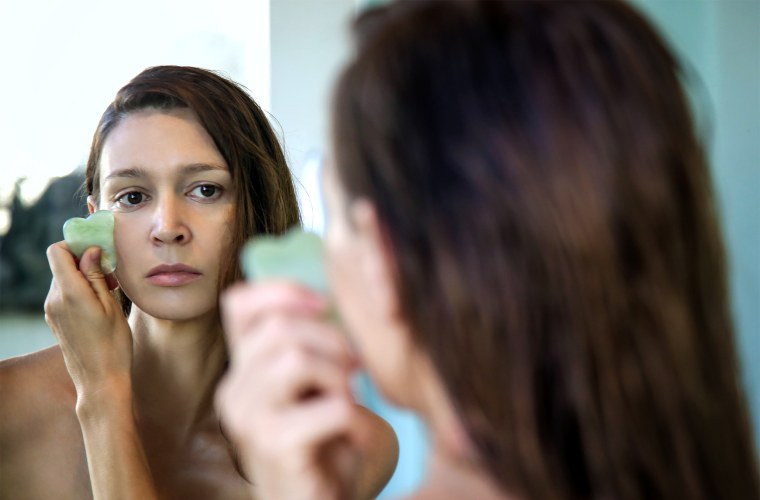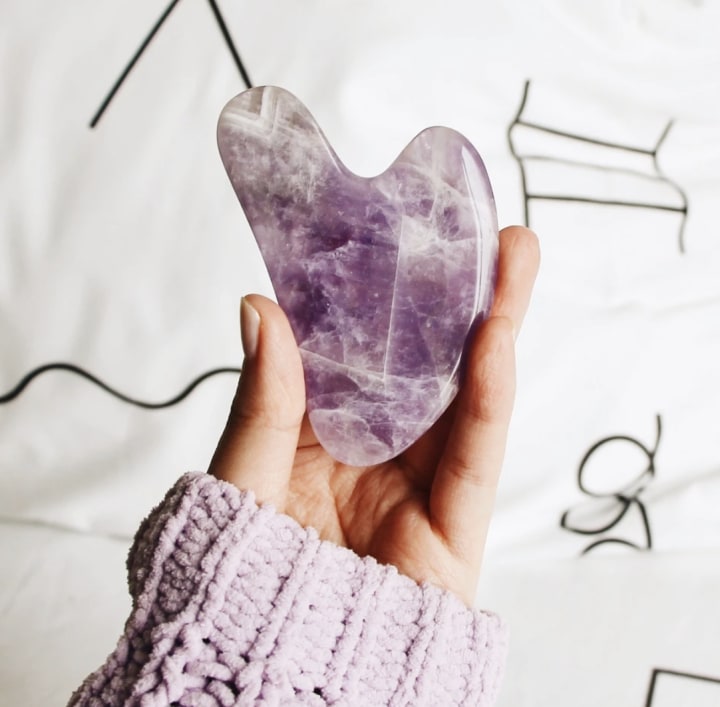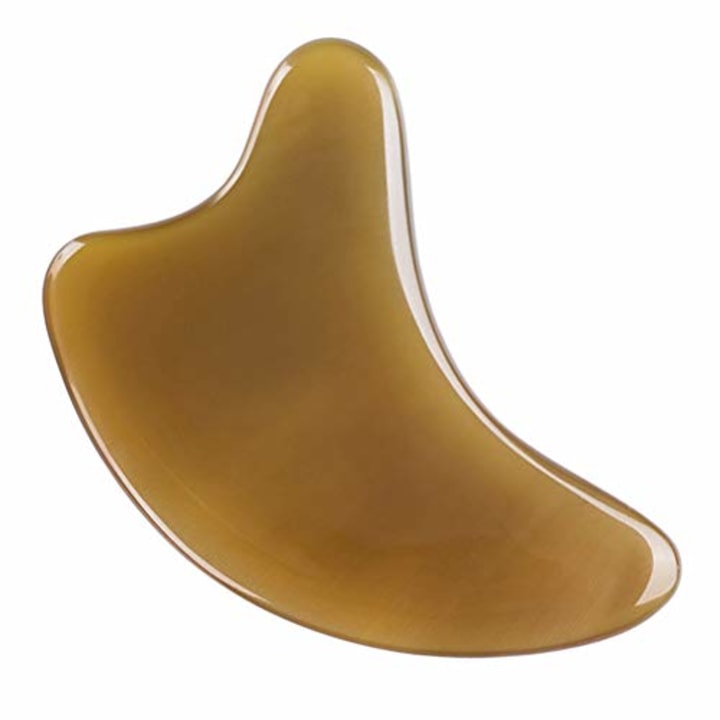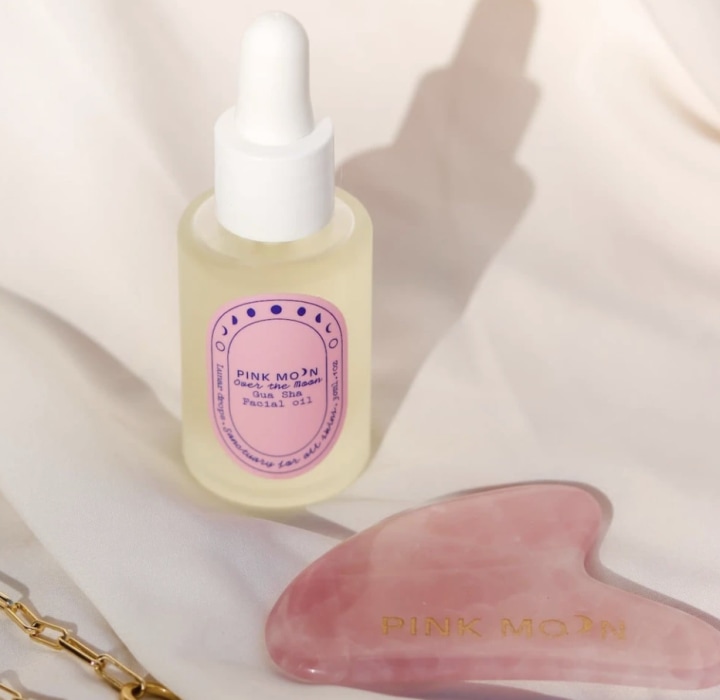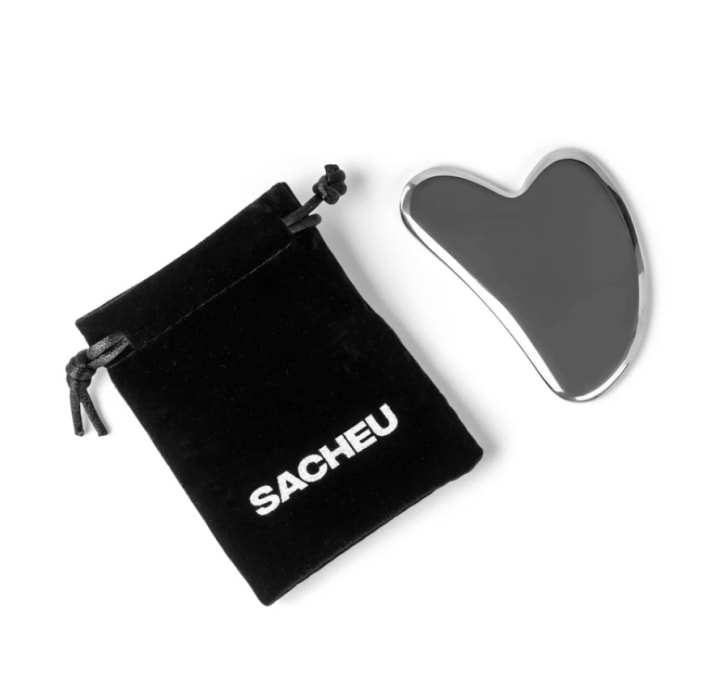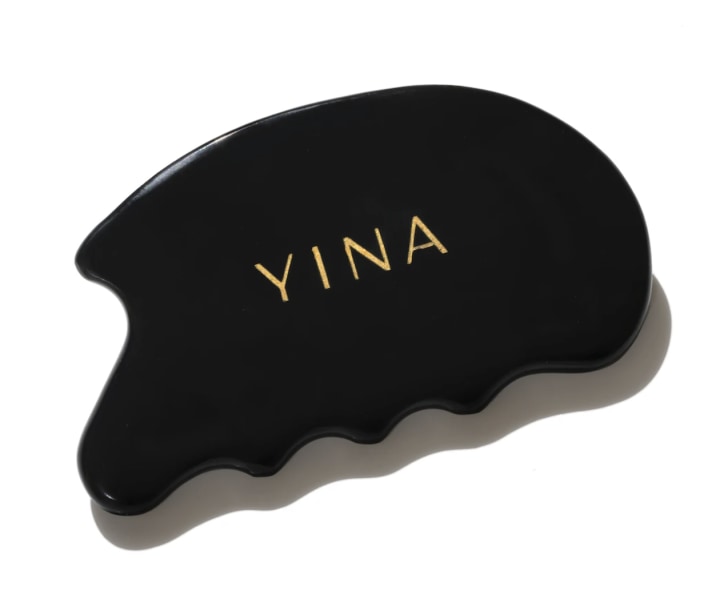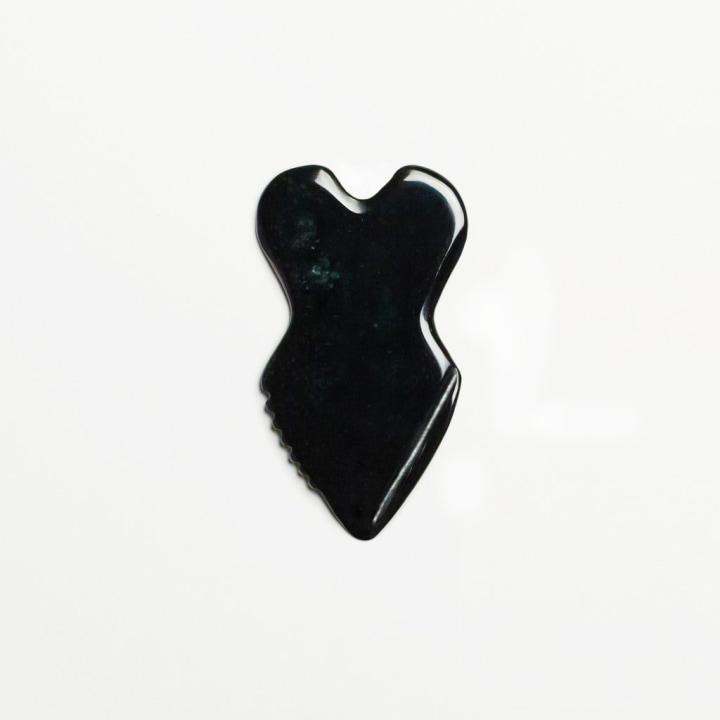If you’ve been on TikTok in the past month, you may have come across gua sha tutorials — or videos in which users apply a smooth, angled stone on their face. Gua sha has recently surged in popularity — so much so, in fact, that at the time of publishing, the hashtag #guasha has accumulated more than 432 million views on TikTok, with users claiming the appliance has cleared their skin, reduced wrinkles and provided a more sculpted appearance. However, while the facial tool has recently exploded in popularity on social media platforms, the practice is nothing new. It actually predates modern medicine and originated in China, where the stones were once used to treat various illnesses.
But what exactly is a gua sha and how can a stone offer so many beauty benefits? To answer these questions, we consulted two traditional Chinese medicine practitioners: board-certified acupuncturists and traditional Chinese medicine experts Shaobai Wang, MD, and Sonia Lee, DACM, LAc. They shared the cultural significance of gua sha, the best gua sha techniques and some products to consider if you’re looking to try out this centuries-old practice.
SKIP AHEAD Best gua sha tools
What is a gua sha?
Gua sha, or 刮痧, directly translates to “scratch” and “sand” (here, the sand refers to the raised redness on the skin instead of actual sand). “‘Sha’ is caused by the bacteria or virus toxins, which break the capillaries and form hyperemia areas, or spots in the skin or mucus, and form sand-like scattered or condensed areas,” said Wang. The sand analogy stemmed from the act of performing gua sha, where technicians gently scrape the skin and see tiny dots under the skin emerge; these little granules resemble pieces of sand, which led to their name, Wang elaborated. After applying gua sha, it is common for users to experience redness or tenderness (a sign of blood renewal), but those effects will subside within a few days.
And like many words in the Chinese language, the characters that make up “gua sha” provide insight into what the practice is, as Lee shared. “The Chinese character for ‘Gua’ (刮) is composed of the character for ‘tongue’ on the left and ’knife’ on the right. The Chinese character for ‘Sha’ (痧) is composed of ’illness’ or ’disease’ on top and ’sand’ on the bottom,” she explained.
As a treatment in traditional Chinese medicine (TCM), gua sha utilizes a solution (face oil, vaseline or water) and a smooth material (jade plates, metal plates and even spoons) to stimulate a specific area of the body. Unlike what’s popularized on TikTok, gua sha is not limited to just the face, but can be used on the back and shoulders as well, experts told us.
What are the benefits of gua sha?
While records of gua sha usage started emerging in the Ming Dynasty, it is still a commonly used TCM technique today. Practitioners have found it helpful for alleviating pain as well as increasing circulation and energy flow. And while there have been many Chinese studies regarding the efficacy of gua sha, it is only recently that American researchers have begun publishing their own findings. Among those listed above, gua sha also helps:
- Promote blood circulation. “From a Chinese medicine perspective, the Tai Yin meridians (composed of the lung and spleen) and Yang Ming meridians (composed of the large intestines and the stomach) are responsible for your skin's overall health,” said Lee. “When you gently scrape the skin on your face with your gua sha tool, what you are doing is stimulating your Yang Ming meridians. You are also sending your body a signal that this area needs more blood circulation.”
- Improve fine lines and wrinkles. Gua sha “can temporarily improve the appearance for the newly and very gentle ones,” Wang said. However, she noted that “for long-standing wrinkles, gua sha should not be the first choice.”
- Promotes lymphatic drainage. Gua sha can eliminate fluid build-up, which can in turn reduce puffiness, experts said.
- Relieves tension from muscles. Experts noted that by applying pressure with a gua sha tool regularly, users can untangle knotted areas and release built-up muscular tension.
Though some TikTokers have claimed that they have used gua sha to sculpt their faces, Wang noted that the gua sha cannot enhance a user's jawline. Instead, gua sha works by engaging tissue to eliminate fluid build-up in the lymph nodes (which can give the illusion of a more contoured face) — it can’t actually remove fat from certain areas.
Lee also recommended that people with weak immune systems (those who struggle with seasonal allergies or tend to catch colds easily) try gua sha. As Wang explained, this is especially useful for those people because by repeatedly stimulating certain areas, gua sha helps purge non-circulating blood and toxins from the body. Visual signifiers of this purging can be anything from redness to slight bruising.
Best gua sha tools
When considering a gua sha tool, experts recommend looking for something that fits well in your hand — something that is comfortable and not too overwhelming. Regarding the material the tool is made from, experts say it is completely up to you. In TCM, certain stones are related to specific goals. For example, Lee shared that quartz benefits the immune system while strengthening your cardiovascular system. On the other hand, she shared that jade, which has a long history in Chinese culture, is used to cool and purge the body from toxins.
Mount Lai Gua Sha
Mount Lai’s gua sha is one Lee’s favorites because it is a nice size and fits nicely in her hand. “They also have different edges for scraping larger and smaller areas,” she elaborated. “Mount Lai also has gua sha tools that look like a spoon, and you can use this as ancient people had done long ago.” This version, made of crystal amethyst, relieves stress, cleanses negative energies and promotes relaxation, according to the brand. The brand also offers a jade and rose quartz version for pre-order.
SUPVOX Natural Buffalo Horn Gua Sha
Wang prefers gua sha tools made of buffalo horn, which is an animal-derived product widely used in TCM. Known for dispelling heat and cooling blood, this one by SUPVOX has garnered a 4.4-star average rating from 10 Amazon shoppers. Buffalo horn “hardness is just in the range of need,” he said. “Additionally, it is a TCM herb with the function of clearing heat and detoxifying.”
Pink Moon Over the Moon Duo
If you’re just getting into gua sha, consider this set by Pink Moon. Not only does the set come with a gua sha tool and facial oil, but for another $20, you can attend a gua sha workshop led by a traditional Chinese medicine practitioner. Made from sunflower and moringa oils, the non-comedogenic oil works to hydrate and protect the skin against environmental stressors, according to the brand. Founder Lin Chen included gua sha in her AAPI-owned beauty and wellness brand out of an initial interest in celebrating traditional Chinese medicine and her heritage. “I want to contribute to the diverse voices in this industry and push for more inclusivity and positive change,” she told us.
Sacheu Beauty Gua Sha
Sacheu Beauty is another AAPI-owned brand that carries gua sha tools. Unlike the Pink Moon version, however, this one is made of stainless steel. According to Sacheu, the tool has “self-cooling” capabilities, meaning it is naturally cold to the touch and users don’t have to put it in the fridge before each use. The tool has garnered a 4.9-star rating from over 350 Sacheu Beauty shoppers.
YINA Bian Stone Gua Sha
For those searching for a gua sha that works on both the face and body, consider this one by YINA that has a larger surface area. Dr. Ervina Wu’s gua sha is made of bian stone, which the brand says can cleanse the user's aura and balance the body’s energy. Additionally, it also features four different edges — Notch, Point, Ripple and Curve — to pinpoint a wide variety of pressure options.
Lanshin Pro Gua Sha Tool
Designed by acupuncturist Sandra Lanshin Chiu, this gua sha tool is uniquely shaped — featuring a heart-shaped and pointed side. Made of Nephrite Jade, the multiple shapes allow users to target different parts of their face. In China, Nephrite Jade is known as “He Tian” jade and is credited with several healing properties, according to the brand.
How to use a gua sha
If you’re looking to start practicing gua sha on your face, the first step experts recommend is cleansing. By starting with a clean face, you can ensure your face is free from any impurities that may get into your skin when scraping. From there, lather facial oil to protect your top layer of skin from abrasion.
“From a Chinese medicine perspective, when performing gua sha, you should follow the meridians,” said Lee. For gua sha on the face, the meridian to follow is the Stomach meridian. Once you locate your body’s Stomach meridian, you can use that to guide where the gua sha should be on your face by drawing an imaginary line up. Then “work upwards and outwards, which means you are moving from the Yin side to the Yang side,” Lee advised.
Once you locate your meridian, hold the tool flat against the face. Move the gua sha from your forehead and motion in an upwards direction, applying a gentle pressure as you go. Then, move the tool to your cheeks, moving the device outwards from the nose to the ear in a “swoop” motion. Finally, flip the gua sha around to the two curved sections. Moving from the chin, scrap along your jawline until you reach your ear. For best results, experts suggest engaging in these movements for about 10 minutes. Another important thing to remember is to scrape in one direction: By channeling the motion in one direction, you will attract more blood and stimulation to a specific area.
If you’re looking to enhance blood circulation to your back or shoulders, Lee recommended the following:
- Back: If you are focusing on your back, you should follow the Urinary Bladder meridian located near your spine. Follow this meridian by starting from the upper part of your spine and moving to the lower part. Focus on one side of the spine first, and then you can move onto the other side.
- Shoulders: If you are focusing on your shoulders, you should follow the Small Intestine meridian by moving your gua sha tool from the middle of your upper back, where you find your spine, outward to the end of the shoulder.
Catch up on Select's in-depth coverage of personal finance, tech and tools, wellness and more, and follow us on Facebook, Instagram and Twitter to stay up to date.
